Amazon's On-Demand AI: Path To Adoption Through AI-As-A-Service (NASDAQ:AMZN)

In the quickly expanding world of artificial intelligence (AI), offering AI capabilities through cloud services that can be accessed whenever needed is becoming increasingly popular. This method is commonly referred to as AI-as-a-Service (AIaaS). Additionally, machine learning (ML), a subset of AI, is now available as a service in the cloud, and the overall concept of this is termed Machine Learning-as-a-Service (MLaaS).

This blog post investigates AIaaS/MLaaS, specifically looking at the AI options offered by Amazon's (NASDAQ: AMZN) AWS. It explores how this cloud-based platform enables businesses to fully utilize the power of AI through cloud computing. By exploring the wide range of AI products and services offered by AWS, and how seamlessly they integrate into Amazon's extensive ecosystem, this analysis demonstrates how AWS utilizes AIaaS/MLaaS to make advanced machine learning tools, data analytics, and natural language processing (NLP) more accessible to all. As a result, it is revolutionizing various industries and driving the global growth of AI-driven solutions.
By examining how Amazon has excelled in various "as-a-service" models such as SaaS, IaaS, and PaaS, and taking into account the remarkable AI capabilities of AWS, this analysis argues the importance of AIaaS/MLaaS and how they can revolutionize the widespread use of AI while empowering businesses to succeed in an AI-centric society. Furthermore, I delve into the future of Amazon and how their triumph in the field of AI could significantly boost their long-term profitability and valuation.
While many studies about AI revolve around prominent chip and GPU manufacturers like NVIDIA (NVDA) and Taiwan Semiconductor (TSM), and their competition for dominance in the AI semiconductor market, this study focuses on the grassroots acceptance of AI. It examines how easily AI can be integrated into everyday business applications and the companies or platforms that enable this integration. I believe widespread adoption of AI will only occur when it becomes accessible to small and medium enterprises (SMEs), regardless of their budget or expertise. Thankfully, thanks to AIaaS/MLaaS and the cloud platforms that offer these services, integrating AI and ML into business applications is becoming increasingly straightforward for most companies.
AIaaS/MLaaS: Revolutionizing Business Dynamics
Just like how the SaaS model and its different types have transformed businesses by lowering expenses, promoting collaboration, enabling flexible development and deployment, and offering adaptability and versatility in software and hardware setups, AIaaS/MLaaS offer similar benefits for companies seeking to incorporate AI and machine learning into their core operations. These innovative models empower businesses to integrate advanced AI capabilities without requiring extensive expertise or expensive infrastructure investments. For instance, a B2C sales company can swiftly implement AI chatbots that utilize an NLP model provided by an AIaaS/MLaaS provider, without needing to go through complex processes to create and maintain a functioning NLP system. Once deployed, the NLP system is taken care of by the AIaaS/MLaaS provider, and the B2C business can expand its usage of the NLP model as it sees fit.
AWS is leveraging its proven knowledge in cloud computing to enter the field of artificial intelligence. Competitors like Microsoft, IBM, and Alphabet are also making significant strides in incorporating AI tools into their own cloud computing platforms, creating a competitive landscape for AI-as-a-Service and Machine Learning-as-a-Service.
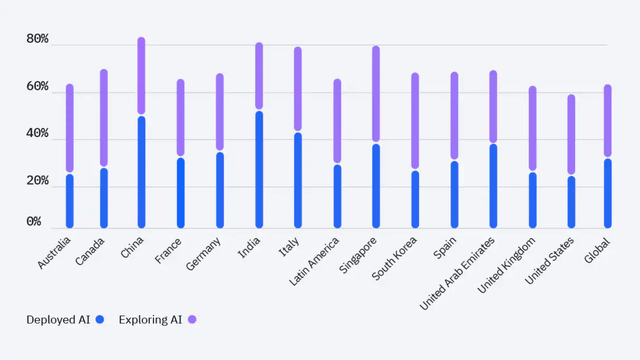
Amazon offers various managed services and products to companies, such as Amazon SageMaker, Amazon Bedrock, and Amazon Rekognition, for developing AI-powered applications. AWS AI provides a range of foundational AI models, including the Amazon Titan large language model (LLM), which businesses can modify and train with their own data to suit their specific needs. Companies and organizations developing on AWS AI can take advantage of the reliable security and scalability features that AWS is renowned for.
Microsoft's cloud platform for artificial intelligence, Azure AI, offers businesses advanced software development kits (SDKs) and application programming interfaces (APIs), such as Azure ML Package for Python. Businesses can also utilize Machine Learning Operations (MLOps) tools and pre-trained AI models to easily create and implement intelligent applications powered by AI. Recently, Microsoft introduced a new coding language model known as Phi-1. Earlier this year, Microsoft made a significant $10 billion investment in OpenAI. Some of the products within Azure AI include Azure Cognitive Services (a collection of APIs that enable quick integration of AI capabilities into applications for developers and data scientists), Azure Cognitive Search (an AI-as-a-Service solution that helps developers build advanced AI-powered search experiences for applications), and Azure Machine Learning (a suite of products that assist data scientists and developers in creating, deploying, and managing high-quality AI models faster).
IBM, a leader in the realm of artificial intelligence, is not neglecting AI as a Service (AIaaS). IBM Watsonx serves as IBM's AIaaS framework, placing emphasis on providing enterprise AI solutions. Watsonx showcases an assortment of feature-rich offerings that empower developers and data analysts in constructing and executing AI models effortlessly. With Watsonx, developers and data analysts gain access to a wide array of pre-designed AI models from both IBM's Foundation Library and the Hugging Face Library. Watsonx is divided into three components - watson.ai (a platform for AI developers), watson.data (an advanced data repository), and watson.governance (a set of tools for overseeing AI implementation).
Google Cloud provides a complete data system, artificial intelligence tools, and user-friendly resources that give developers and data analysts the ability to quickly make AI applications. At the core of this offering is Google Cloud's unified AI platform, Vertex AI. Within Vertex AI, developers can use pre-trained APIs. The AutoML feature in Vertex AI lets developers, even those without much machine learning knowledge, train accurate AI models that meet their specific business needs. One of the top models in the AI industry, Google's PaLM 2 LLM, is available. Similar to IBM's Watsonx, developers can also explore a wide range of ready-to-use AI foundation models and pre-trained APIs in the Vertex AI ecosystem.
These big players in the cloud industry provide high-level, customizable AI and machine learning solutions that can be accessed instantly. Their wide array of products and consistent investments in AI and ML cloud services demonstrate that AI is not just a temporary fad; it is a permanent fixture that is reshaping industries and bringing about significant changes.
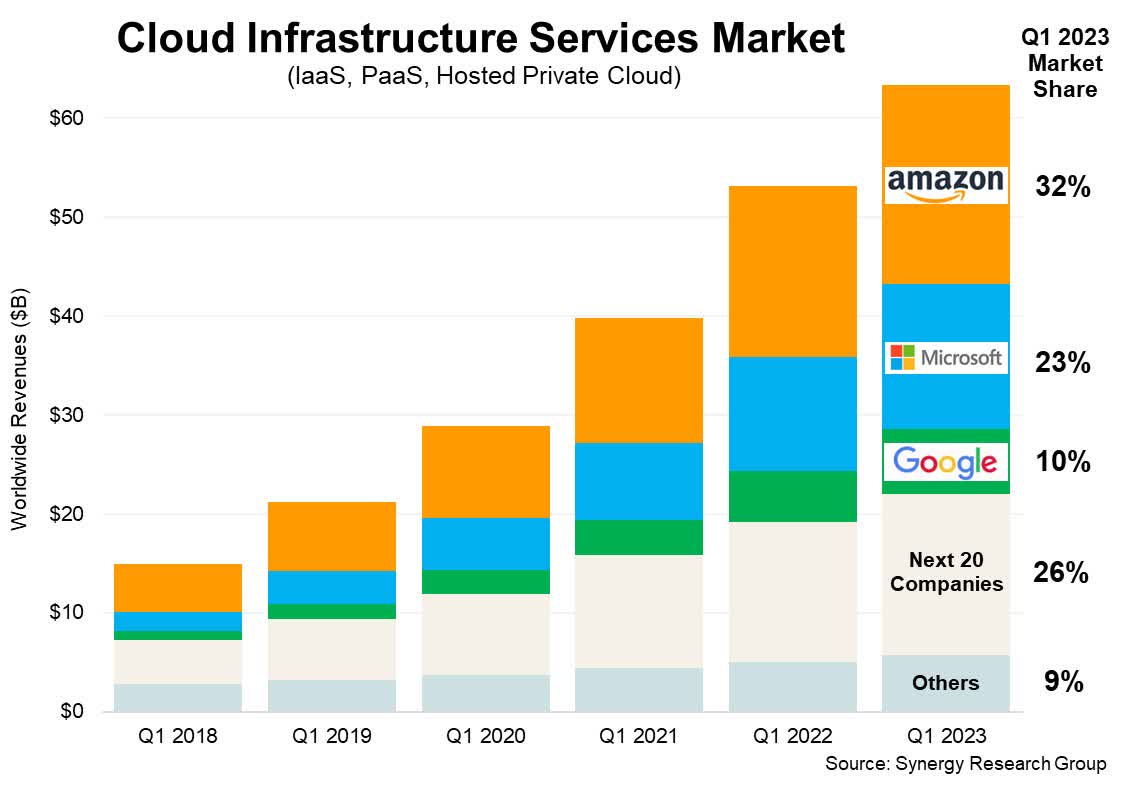
The 2022 IBM Global Index on the Adoption of Artificial Intelligence (AI)
The infographic above, which was released by IBM's Global AI Adoption Index research in May 2022, shows that 35% of surveyed companies have already incorporated AI into their activities. Furthermore, an extra 42% are currently investigating the potential integration of AI.
Why AWS Will Lead AIaaS/MLaaS - A Qualitative View
With every major player in cloud infrastructure revealing their advanced AI-as-a-Service (AIaaS) and ML-as-a-Service (MLaaS) solutions, attracting businesses, developers, and data analysts, I want to emphasize the reasons why I believe AWS has the opportunity to capture a larger portion of the AIaaS/MLaaS market compared to Microsoft's Azure AI, Google Cloud AI, and IBM's Watsonx. Let's delve into the crucial factors that support this viewpoint:
Customer Market and Incorporation: The wide-ranging pool of customers that Amazon possesses, who already employ AWS for diverse cloud services, provides the company with a favorable position in terms of AI offerings. The effortless assimilation of AI functionalities into the existing AWS framework entices enterprises that already heavily rely on Amazon's interconnected system. With the increasing incorporation of AI in their applications by numerous businesses, I am confident that AWS will maintain the larger portion of their current customer base.
User-Friendly Environment for Developers: AWS has gained a reputation for its interface that is easy to navigate and its toolset designed to streamline the process of creating and launching applications. This simplicity can appeal to a wider range of users, including businesses lacking extensive AI knowledge. Numerous studies conducted independently have consistently rated AWS as the preferred option for developers creating cloud applications.
The collaboration of Amazon's retail and e-commerce dominance with AWS results in a powerful combination that allows AWS to provide convenient and seamless AI features designed specifically for the retail and logistics sectors. This harmonious partnership has the ability to entice companies in search of pre-developed, industry-focused AI solutions.
Embracing Change and Persistent Growth: Amazon's unwavering commitment to embracing change and achieving continuous growth is in harmony with the ever-changing AI field. The company's impressive history of introducing fresh services and functionalities has the potential to maintain AWS as a leading provider of AI-as-a-Service and Machine Learning-as-a-Service. Presently, numerous customers are actively exploring the newly launched AI service of Amazon called Amazon Bedrock.
Although Azure AI from Microsoft, Watsonx from IBM, and Vertex AI from Google all have their own advantages and customer bases, AWS from Amazon stands out with its strong presence in the cloud market and its user-friendly ecosystem for developers. This puts AWS in a good position to potentially gain a larger share of the market. However, it is important to keep an eye on the competition between these leading platforms and stay updated on the latest trends in the AIaaS/MLaaS market.
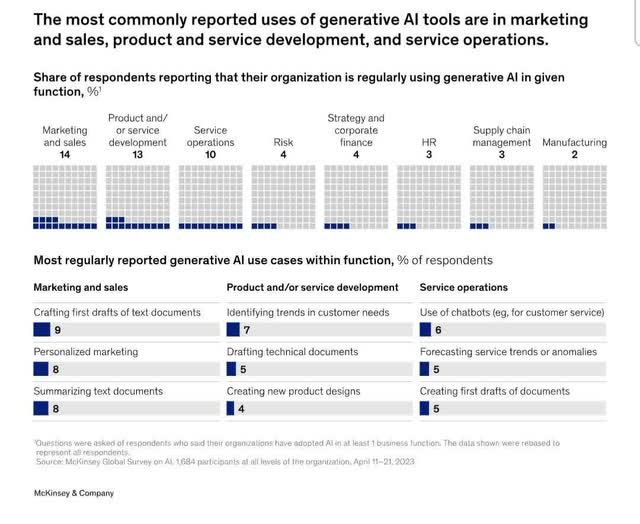
In general, Amazon is showing great commitment to its AI/ML cloud business. A recent article disclosed that AWS has made a significant financial commitment of $100 million to create a cutting-edge Generative AI Innovation Center. This facility will serve as a hub for companies and organizations looking for guidance on incorporating AI/ML technology. Here, they will collaborate with top-notch experts in AI/ML and generative AI from AWS, benefiting from their vast knowledge and skills.
Potential AIaaS/MLaaS Growth And AWS Benefits
According to market research, the generative AI industry is expected to expand from $43.87 billion in 2023 to $667.96 billion in 2030. This growth will be fueled by the desire to establish virtual realms and utilize AI-driven marketing and sales techniques. The marketing and advertising sector, in its pursuit of enhancing customer satisfaction, will play a major role in driving this expansion. Naturally, with the projected growth of the generative AI market, there will also be an increased demand for AI-as-a-Service and Machine Learning-as-a-Service tools and services. This is due to the fact that most generative AI applications will rely on the foundation models offered by these AIaaS/MLaaS providers.
In addition, numerous studies and analyses have projected significant expansion for the AI services and machine learning services markets. According to a report released by SkyQuest in June 2023, the worldwide AI services market is anticipated to reach a value of $187.98 billion by 2030, with a compound annual growth rate of 48.2% from 2023 to 2030. Likewise, there is an expected surge in demand for machine learning services during the same projected timeframe.
The earnings of AWS for each quarter from the first quarter of 2014 up to the fourth quarter of 2022 can be found on Statista.com.
In the last ten years, the revenue of AWS has consistently increased over time. During the first quarter of 2014, the revenue was $1.05 billion. With a compound annual growth rate (CAGR) of approximately 34%, the revenue of AWS reached $21.4 billion by the fourth quarter of 2022. However, in the first quarter of this year, there was a decrease in the rate of growth. Amazon acknowledged this decline during its earnings call for Q1 and stated that it was a result of macroeconomic uncertainties. These uncertainties caused businesses and enterprises to cut back on their spending for cloud services.
The blog post on Amazon's Q2 2023 report indicates that the growth rate of AWS remains steady, which is a more positive result compared to the expected decrease in Q1. The revenue generated by AWS in Q2 amounts to $22.1 billion, and it has an operating income of $5.4 billion. Although Amazon is primarily known as a dominant player in the retail industry, a significant portion of its total operating income of $7.7 billion for Q2, specifically 70%, is attributed to AWS.
...our aim is to make generative AI accessible to everyone, reducing the expenses associated with training and operating models. We want to provide the freedom to choose from a variety of extensive language models, rather than being limited to a single option. Additionally, we strive to simplify the process for businesses of any scale and technical competency to personalize their own language model and develop secure, enterprise-level generative AI applications.
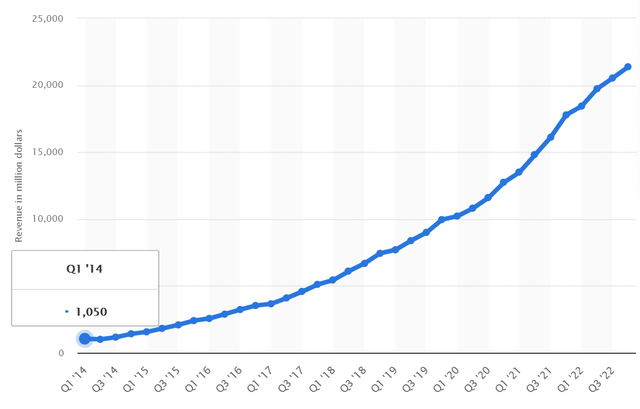
Amazon's Q2 2023 Earnings Call Transcript
The recent rise in the popularity of AWS cloud services has been linked to the growing need for AI cloud services. During the Q2 2023 earnings call, Amazon expressed its ambitions for the field of artificial intelligence.
We consider the middle layer as a service that provides vast language models. Taking a step back, the creation of these models requires a significant investment of billions of dollars and several years. Instead of investing in building these models themselves, many companies express their desire to utilize these large language models. They want the ability to customize them with their own data while keeping their proprietary information separate from the general model. Additionally, they require the security, privacy, and platform features offered by AWS to be compatible with this enhanced model. Ultimately, they seek a managed service that encompasses all of these aspects.
Original: During the second quarter of 2023, Amazon held its earnings call to discuss their financial results. Below is a transcript of the call. Rewritten: In the second quarter of 2023, Amazon conducted a conference call to share their financial performance with investors. The following is a written record of the call.
During the recent earnings conference call, the leadership of Amazon once again emphasized their dedication to creating and making widely available advanced language models. These models usually require significant resources and time to develop, but Amazon aims to offer them as a service. To achieve this goal, Amazon integrates foundational models from various AI labs like A121 Labs, Anthropic, Cohere, and Stability AI into their platform, known as Amazon Bedrock. This strategic move showcases Amazon's intent to enhance its position as a comprehensive AI service provider.
Insights from the Financial Quarter Reports Concluding on June 30th
Year on Year Increase in Sales
Information obtained from the reports of Amazon, Microsoft, and Google for the periods ending on June 30 reveals the comparison of the major cloud segments. It should be noted that Microsoft does not disclose sales figures solely for Azure. Instead, they include Azure, other server software products, and enterprise products and services under their Intelligent Cloud segment. Hence, I believe that AWS emerges as the ultimate leader in terms of revenue, profit, and market share in the cloud industry.
AMZN is generating a lot of positive sentiment from analysts who recommend buying the stock. This is because they were pleasantly surprised by the Q2 earnings per share, which exceeded expectations by 89.54%. In the past three months, analysts have made only positive revisions to their forecasts for AMZN, with no downward revisions. The Q2 results also revealed impressive year-on-year growth of 133.3% in operating income and 74% in operating cash flow. Looking ahead to Q3, analysts expect earnings per share to increase by a staggering 180% compared to the same period last year, with a projected estimate of $0.56. They also anticipate a total of $2.13 in earnings per share by the end of the fiscal year 2023. These rosy predictions are based on the strong revenue and earnings performance of AMZN, as well as positive guidance for Q3. All in all, the future looks bright and optimistic for AMZN.
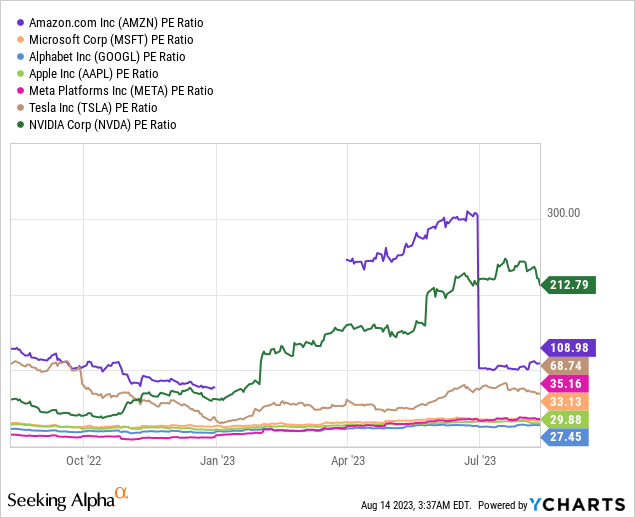
Over the past ten years, AMZN has consistently had a higher P/E ratio compared to other large tech companies. AMZN's P/E ratio has also been higher than the average for its industry, indicating that investors are willing to pay more for Amazon's earnings compared to its competitors. Currently, AMZN's P/E ratio based on GAAP (Trailing Twelve Months) is 108.98x. The median P/E ratio for the past ten years is 149.23x. Based on this historical median, I believe that AMZN's current valuation is fairly in line with its P/E trend over time. I prefer using the median P/E ratio instead of the mean because extreme values, such as a high P/E of over 1000x and the current P/E of 108.9x, would heavily influence the mean calculation.
The Forward Price-to-Earnings (P/E) ratio of AMZN stands at 64.17 based on GAAP. This projected decline in P/E ratio suggests a predicted increase in earnings, which I believe will be reflected in the stock's price going forward, assuming everything else remains constant.
Despite the seemingly smooth path ahead for widespread AI implementation and the dominance of AWS in the AI-as-a-Service and Machine Learning-as-a-Service markets, there are still potential hurdles that might hinder AWS's expansion and profitability in the realm of AI.
The uncertain economic conditions are still a hurdle for the widespread use of AI on-demand and the expansion of the AI as a Service/Machine Learning as a Service sector. As highlighted earlier in this evaluation, the economic uncertainties lead Chief Information Officers (CIOs) to save money by decreasing their technology integration investments.
As worries about data breaches and privacy infringements continue to rise, concerns about privacy could hinder the widespread use of AI. If AI models are developed using confidential or personal information, there is a valid worry that these models could unintentionally mishandle or reveal that data, possibly resulting in breaches of confidentiality. The unpredictable consequences of AI's interaction with sensitive data highlight the necessity for thorough testing, supervision, and ongoing improvement of these models.
There is a possible danger that exists in the growing competitive environment, which might potentially impede AWS' path to achieving dominance in the field of artificial intelligence. Alongside influential cloud competitors such as Microsoft and IBM aiming for supremacy in AI as a service, Amazon must consistently generate new ideas and provide distinctive benefits to keep its advantageous position in the market.
Another important concern is the significant initial and ongoing costs needed to set up and keep AI data centers operational. These facilities rely on specialized AI hardware called AI accelerators. This considerable financial obligation has the potential to hinder the ability to generate profits. As the use of AI grows, the expenses associated with infrastructure, hardware, and continuous maintenance will also rise. This could put a strain on financial resources and delay the achievement of desired outcomes.
AWS operates its exclusive AI processors created to enhance efficiency for its advanced data infrastructure that can support AI. The chips are crafted and manufactured by its affiliated company Annapurna Labs. The creation of specialized accelerators such as AWS Trainium and AWS Inferentia requires substantial investments in research, innovation, design, facilities, and production machinery.

When it comes to AI chips, both Google and Microsoft are heavily involved in creating their own. Google is particularly focused on its AI chip called Tensor Processing Units (TPUs), which are used in its powerful AI supercomputer called TPUv4. Microsoft is also working on its own AI chip called Athena, which has been in development since 2019. These investments and developments highlight the intense competition between top cloud computing providers to advance AI technology and establish themselves in the AI field.
As the use of artificial intelligence (AI) continues to increase, Amazon Web Services (AWS) has the potential to greatly improve the abilities of businesses through AI. The increasing popularity of generative AI and the need for AI-as-a-Service (AIaaS) and Machine Learning-as-a-Service (MLaaS) tools aligns with Amazon's goals, potentially leading to significant revenue growth. Despite challenges such as uncertain economic conditions, worries about privacy, competition, and high initial capital expenditures (CaPex), Amazon's investment in innovative technology and its dedication to making AI accessible to all put it in a strong position to overcome these obstacles and remain at the forefront of the market.
The use of AIaaS/MLaaS will play a significant role in providing generative AI to developers and businesses. This means that they can access and make use of generative models for various purposes without the hassle of creating and managing the models themselves. Experts anticipate that generative AI will have a profound impact on the worldwide economy. According to Goldman Sachs, generative AI has the potential to disrupt and increase the global GDP by 7%. The CIOs of leading companies are highly optimistic about the possibilities that generative AI offers. Generative AI, facilitated by AIaaS/MLaaS, is an unexplored market, and in my opinion, AWS is in a favorable position with a dominant presence.
Starting from 2014, a minimum of half of Amazon's profits from its operations has come from AWS. However, this proportion has now risen to 70% for the second quarter of the year. Following the release of Amazon's Q2 report, all attention has been focused on the positive aspects of AWS. AWS is widely recognized as the cornerstone of Amazon's financial success. In my opinion, Amazon will make deliberate investments in this vital segment, which has become its main source of income, in order to ensure continued growth and profitability.
Note from the Editor: This blog post was entered into Seeking Alpha's investment competition called Best AI Ideas. The competition will be running until August 15 and offers cash prizes. It is open to all contributors, so don't pass up this opportunity. If you want to participate and submit your own article, click here for more information and submit it today.
The following blog entry/blog post was authored by
Mandela has been an avid follower and trader of cryptocurrencies since 2017. He has a deep interest in programming and enjoys sharing his knowledge on cryptocurrencies and different investment approaches in the crypto world. Mandela possesses a profound understanding of distributed ledger technology, the technology stack behind Web3, and the art of crypto investing. He takes pleasure in conducting extensive research and analysis on various cryptocurrency projects, emerging trends in Web3, and the realm of security tokens (also known as digital securities). Furthermore, Mandela actively contributes as a writer to James Foord, an analyst featured on Seeking Alpha.
Analyst's Disclaimer: I do not own any stocks, options, or similar financial instruments in the mentioned companies, and I have no intention to acquire such positions in the next 72 hours. I independently authored this article and all the opinions expressed within it are my own. I am not receiving any form of compensation for this article (apart from possible remuneration from Seeking Alpha). Additionally, there are no business affiliations between myself and any company mentioned in this article.
Seeking Alpha's Disclaimer: Previous performance does not guarantee future outcomes. We are not providing any suggestions or guidance on whether a specific investment is suitable for an individual investor. The thoughts or opinions expressed above may not represent the views of Seeking Alpha as a whole. Seeking Alpha is not an authorized broker, dealer, investment adviser, or investment bank in the United States. Our analysts consist of third-party authors, including both seasoned investors and individual investors who may not possess any certifications or licenses from regulatory bodies.









































